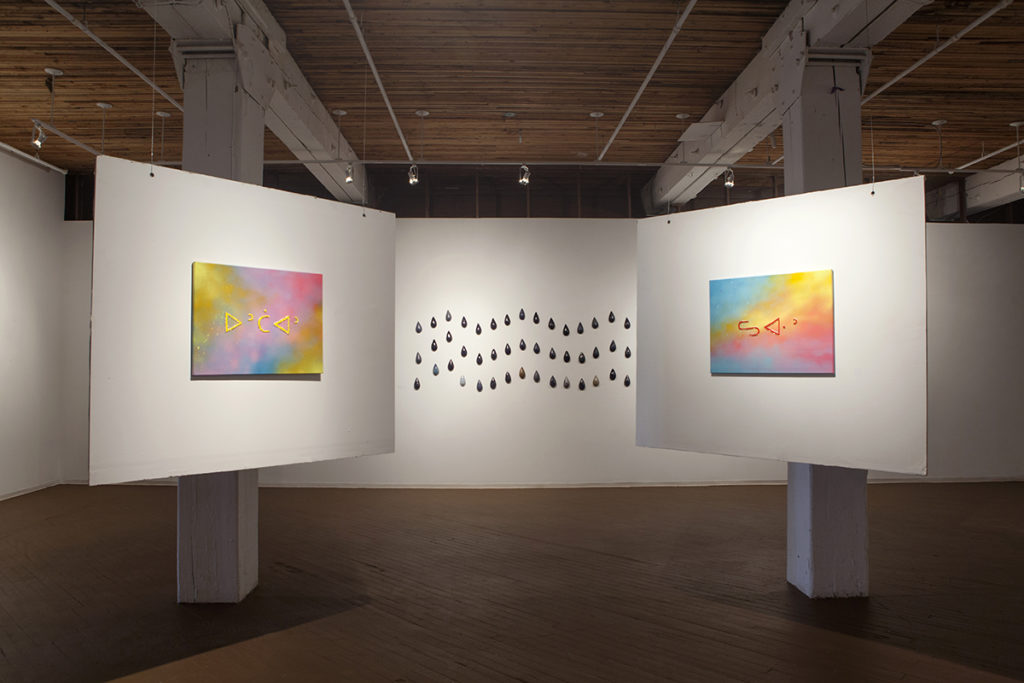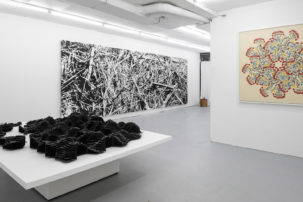The term “sugarcoated” describes an indirect, insincere, or timid way of addressing reality. In “[shooger-koht-ed] / ZiizibaakwadAgoke / Ésíwinikátéki,” curator Janell Henry implicated the sugarcoated and superficial language used by individuals and the government to address Indigenous rights. While the curatorial text identified language use and Indigenous language revitalization as key to discussions of reconciliation—itself a sugarcoated word, as Henry points out—the works of Jessica Canard, Catherine Forest, Scott Benesiinaabandan and Bret Parenteau intertwined these concerns with socio-politics, culture, ceremony and environment to make necessary links between past, present and future.
Stepping inside the space demarcated by Jessica Canard’s installation of four paintings, I saw beaded Ojibwe syllabics within brightly coloured backgrounds, each work referring to a direction: Giiwedin | North, Ondaaban | East, Zhaawan | South and Ningaabii’an | West. I learned from the curator’s text that the installation evoked a sweat lodge, a place of ceremony. By visually representing the Ojibwe language within this physical structure, Canard pointed to the interconnectedness of language and ceremony with place and being. Additionally, at a time when English and French are Canada’s official and most represented languages, her choice to prioritize Ojibwe visually and in the works’ titles took up space and demonstrated a resistance to state narratives.
A number of ceramic pieces by Catherine Forest conveyed her interest in water as it relates to sustenance, survival and our responsibilities to the earth and its resources. In Connect the Drops, numerous ceramic tears formed a handful of waves along one gallery wall. Viewers were encouraged to read this work by “connecting the dots”—to confront the contrast between the life-giving sustenance of water and the work’s metaphorical connection to tears in terms of Indigenous displacement and survival.
At the other end of the gallery, Scott Benesiinaabandan’s virtual reality work encouraged further metaphorical and real relationships to environment, imagining new associations. His new media explorations amalgamated into the creation of a weird, liminal environment in Blueberry Pie Under a Martian Sky. Through a VR headset, I was transported into a wormhole and surrounded by stimuli. Symbols and objects—including birds, a teapot, coffee beans and geodesic structures—floated around as a voice spoke in Ojibwe and English simultaneously to tell a story of people who “went to the new place [and] saw differently.” I could comprehend parts of the English audio and wondered what else could be accessed by listening in each language. With Blueberry Pie, Benesiinaabandan created a strong view into how language and place crucially shape the perception of meaning.
In another room off the main gallery, Bret Parenteau’s Nisidotan and untitled collages similarly focused on intervention and interference into environment. Nisidotan paired a 10-minute excerpt of an experimental sound piece with a video that references the same visual vocabulary used in his collage works: architectural details and textures sampled from outdoor imagery. The audio appropriately accompanied the spliced images: there was an electronic bite, waves of sound and repetitive mechanized noises. In her text, Henry defined “nisidotan” as an Ojibwe word meaning “understand it, recognize it, identify it (by hearing),” which reflects the psychological space Parenteau created, highlighting abstracted sound, also, as a mode of knowing.
At first glance, not all of the artworks in “[shooger-khot-ed]” engaged solely with the curator’s focus on language. Yet, in the context of one another, they remind us that language is caught up in many facets of life—language shapes reality, and ways of being, knowing and understanding. The exhibition took language as a starting point to connect to the presence of history as seen in Canard’s and Forest’s works, and to the making and expression of meaning as in Benesiinaabandan’s and Parenteau’s pieces. These artists reflect a vastly diverse range of subject matter, style and concerns. However, they all use art as a language not to limit reality—as the act of sugarcoating often does—but to represent Indigenous points of view and to expand Indigenous interpretations and futures.
![Installation view of “[shooger-koht-ed] / ZiizibaakwadAgoke / Ésíwinikátéki” at Urban Shaman Gallery, 2019. Photo: Karen Asher.](https://canadianart.ca/wp-content/uploads/2019/08/shooger-kohted-installation-1024x683.jpg)
Installation view of “[shooger-koht-ed] / ZiizibaakwadAgoke / Ésíwinikátéki” at Urban Shaman Gallery, 2019. Photo: Karen Asher.

Catherine Forest, Connect the Drops, 2012. Ceramic, 3 x 22 ft overall. Photo: Karen Asher.

Catherine Forest, Connect the Drops (detail), 2012. Ceramic, 3 x 22 ft overall. Photo: Karen Asher.

Jessica Canard, Zhaawan | South (installation view), 2019. Photo: Karen Asher.

Scott Benesiinaabandan, Blueberry Pie in a Martian Sky, 2019. Virtual reality installation, 12 x 12 x 12 ft. Photo: Karen Asher.

Bret Parenteau, Nisidotan, 2019. Installation with video and cassette tape. Photo: Karen Asher.

 Jessica Canard, Ondaaban | East (installation view), 2019. Photo: Karen Asher.
Jessica Canard, Ondaaban | East (installation view), 2019. Photo: Karen Asher.





